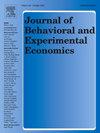女儿,储蓄和家庭财务
IF 1.4
3区 经济学
Q2 ECONOMICS
Journal of Behavioral and Experimental Economics
Pub Date : 2025-06-03
DOI:10.1016/j.socec.2025.102395
引用次数: 0
摘要
我们探讨了在一个强烈支持生儿子的文化环境中,儿童性别和家庭财务决策之间的联系。利用中国家庭金融调查(CHFS)的数据,我们发现女儿的存在与较低的储蓄率有关,这与未婚女性的相对供应不足导致有女儿的家庭与有儿子的家庭的婚姻市场竞争较弱的假设相一致。因此,这些家庭不太愿意为女儿提供更大的资产池,以提高她们的婚姻前景。随着女儿接近适婚年龄,这种相关性变得更加明显,在户主金融知识水平较低、受教育程度有限以及生活在农村地区的家庭中更为常见。本文章由计算机程序翻译,如有差异,请以英文原文为准。
Daughters, Savings and Household Finances
We explore the link between child gender and household financial decisions within a cultural environment that strongly favours having a son. Using data from the China Household Finance Survey (CHFS), we find that the presence of a daughter is associated with a lower saving rate, consistent with the hypothesis that the relative under-supply of unmarried women generates a less competitive marriage market for families with daughters vs. those with sons. As a result, such families have lower incentives to endow their daughters with bigger asset pools to enhance their marital prospects. The correlation becomes more pronounced as the daughter approaches marriageable age, and it is more common among families where the head has low financial literacy and limited education and lives in rural areas.
求助全文
通过发布文献求助,成功后即可免费获取论文全文。
去求助
来源期刊
CiteScore
2.60
自引率
12.50%
发文量
113
审稿时长
83 days
期刊介绍:
The Journal of Behavioral and Experimental Economics (formerly the Journal of Socio-Economics) welcomes submissions that deal with various economic topics but also involve issues that are related to other social sciences, especially psychology, or use experimental methods of inquiry. Thus, contributions in behavioral economics, experimental economics, economic psychology, and judgment and decision making are especially welcome. The journal is open to different research methodologies, as long as they are relevant to the topic and employed rigorously. Possible methodologies include, for example, experiments, surveys, empirical work, theoretical models, meta-analyses, case studies, and simulation-based analyses. Literature reviews that integrate findings from many studies are also welcome, but they should synthesize the literature in a useful manner and provide substantial contribution beyond what the reader could get by simply reading the abstracts of the cited papers. In empirical work, it is important that the results are not only statistically significant but also economically significant. A high contribution-to-length ratio is expected from published articles and therefore papers should not be unnecessarily long, and short articles are welcome. Articles should be written in a manner that is intelligible to our generalist readership. Book reviews are generally solicited but occasionally unsolicited reviews will also be published. Contact the Book Review Editor for related inquiries.

 求助内容:
求助内容: 应助结果提醒方式:
应助结果提醒方式:


